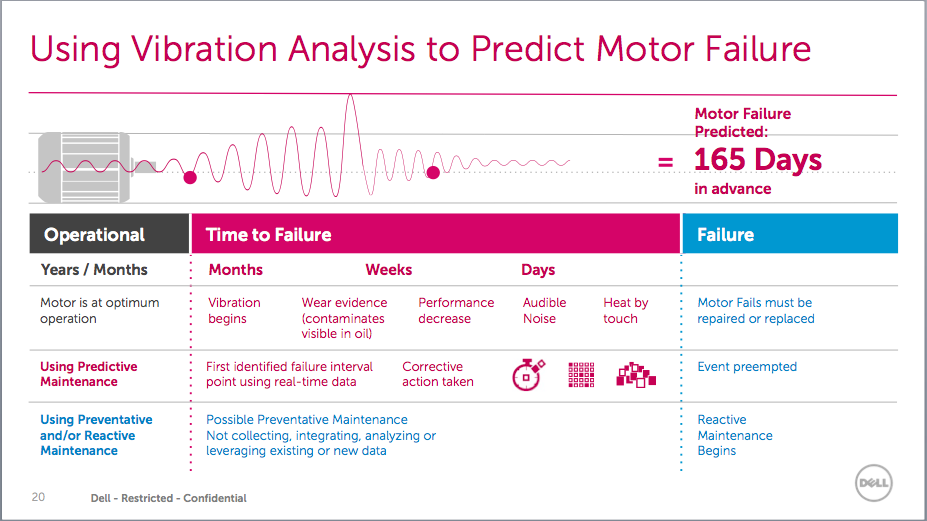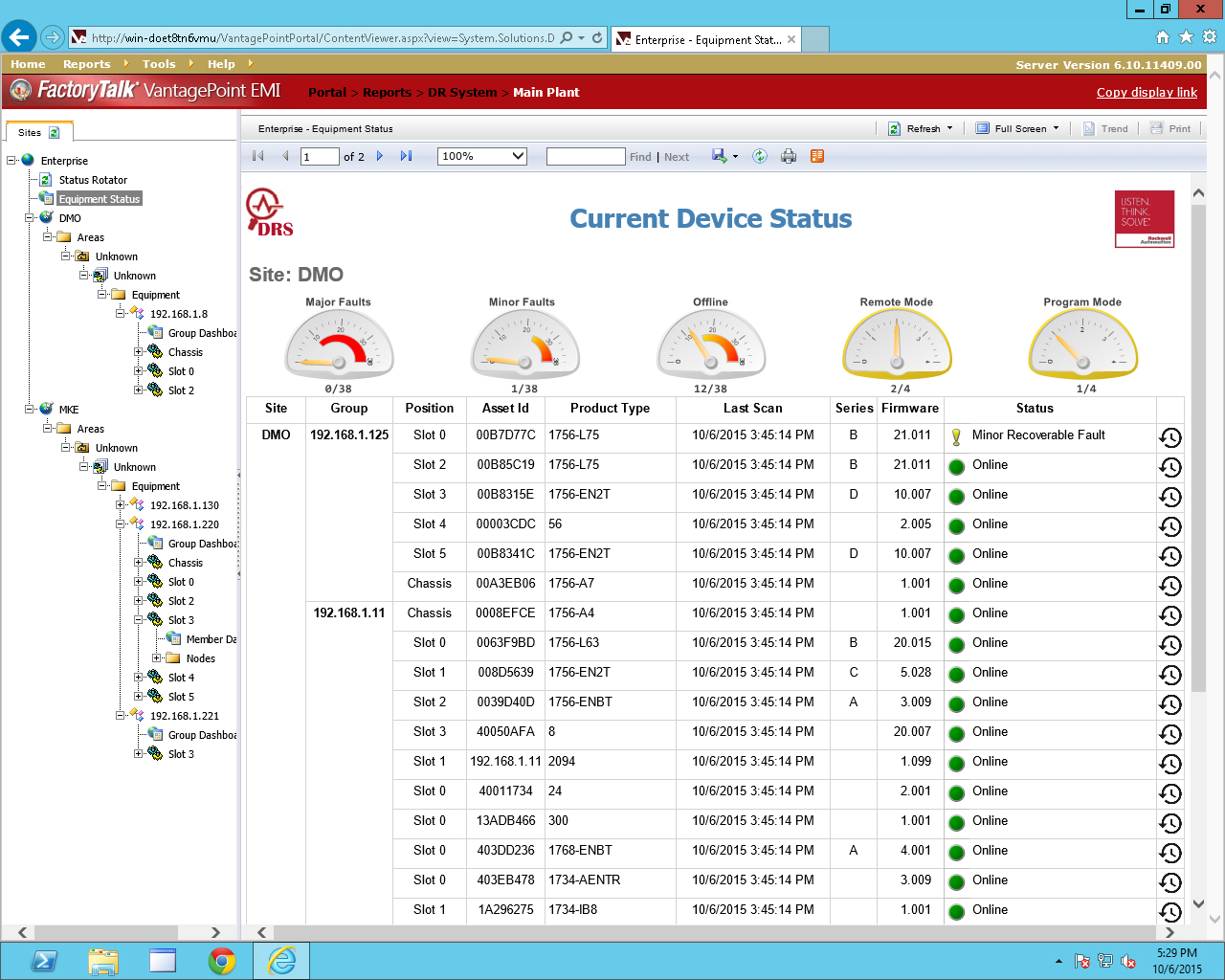
by Gary Mintchell | Jan 18, 2016 | Asset Performance Management, Automation, Internet of Things, Manufacturing IT, Networking, Operations Management, Technology
 Predictive maintenance benefits more from implementation of the Internet of Things than perhaps any other function at this early stage of wide-spread adoption.
Predictive maintenance benefits more from implementation of the Internet of Things than perhaps any other function at this early stage of wide-spread adoption.
I have written on this topic several times over the past couple of years.
Predictive Condition-Based Maintenance
IoT Testbed For Condition Monitoring To Predictive Maintenance
Use Of Internet of Things Enhances Preventive Maintenance
10 Myths About Predictive Analytics (SAP)
A foulup at Starbucks, Preventive Maintenance Prevents Production
Cloud Platforms For Internet of Things
Predictive or Condition-Based
The asset management community has not made it easy for us generalists with its terminology and definitions. Searching for predictive maintenance (PdM) often serves up results for condition-based maintenance. I am not going to attempt a final definition, but I found something that made sense on the OSIsoft Website. “PdM defines methods to predict or diagnose problems in a piece of equipment based on trending of test results. These methods use non-intrusive testing techniques to measure and compute equipment performance trends.”
Condition-based maintenance (CBM) is a methodology that combines predictive and preventive maintenance with real-time monitoring. PdM uses CBM systems to detect fault sources well in advance of failure, making maintenance a proactive process. CBM accurately detects the current state of mechanical systems and predicts the systems’ ability to perform without failure.
Business Risk
The Aberdeen Group, Report: Building the Business Case for the Executive, December 2013, found that 40 percent of 149 manufacturing executives identified failure of critical assets as the top risk they face.
How do we mitigate this risk? Predictive maintenance and condition-based maintenance are methodologies that help. One thing that makes these strategies work is data. With sufficient data along with a model of the asset’s condition at operational efficiency, reliability engineers can begin to predict failures before they happen.
Just like your car, productive assets pick the worst time to fail. This unplanned downtime is exceedingly expensive. Using predictive technologies, managers can plan for shutdowns at an appropriate time. The right parts can be on hand, labor lined up, production schedules adjusted, all because everything can be planned.
I’ve been talking with Dell often since October when I attended Dell World and it unveiled its Internet of Things initiative.
The interesting thing about Dell compared to almost everyone else I cover is that they approach the IT/OT convergence issue from the IT side rather than the OT side.
Dell’s first IoT product is something I think we’ll see more of–analytics at the edge combined with gateway technology that can bring disparate sources of data together, massage them, send them off to the cloud for further analytics, storage, and visualization. Dell’s current partners are SAP for predictive maintenance and Statistica for analytics.
Expect to see more of these partnerships evolve. In some cases, such as PTC, we are seeing acquisitions to add IoT capability. On the other hand, larger companies who do not have enough in common overall to merge will forge partnerships to offer complete solutions to customers.
We see some of this through the rise of Industrial Internet and IP organizations.
Collecting, moving, analyzing, and displaying data is becoming a big and important business. Customer executives will come to appreciate the work as their companies gain efficiency–and profits.

by Gary Mintchell | Jan 11, 2016 | Asset Performance Management, Automation, Internet of Things, Operations Management, Technology
 Remote monitoring and diagnostics is a key driver for the Internet of Things strategy adoption in manufacturing and production. Advances in both the technology and services involved in this area appears to be the area of best economic return these days.
Remote monitoring and diagnostics is a key driver for the Internet of Things strategy adoption in manufacturing and production. Advances in both the technology and services involved in this area appears to be the area of best economic return these days.
Rockwell Automation recently released news about its take on a diagnostic reliability service. Rockwell doesn’t tie it to the Internet of Things, much to its credit. But this solution fits within the broad trend I’ve seen developing.
The solution deploys a layer of technology across plant devices and equipment to monitor and perform analysis, and create a continuous improvement approach to reliability maintenance, reducing operational risk. As part of the service, a Rockwell Automation domain service expert also closely tracks equipment performance to advise on reliability improvements to the production facility.
“Our customers have access to a huge amount of data within their assets, but they often struggle to turn data into useful operational intelligence,” said Ryan Williams, product manager, Rockwell Automation. “In the past, companies relied on maintenance personnel on-site to check the status of equipment in the field and then develop corrective action plans. Now, with the diagnostic reliability service, they can transform maintenance data into asset intelligence. This helps build a more Connected Enterprise, leveraging interconnected data systems and producing actionable information. Companies can better prioritize choices on maintenance and production, and do more with less.”
The solution automatically collects identity and health data from all networked devices on the production control network. The data is then modeled with asset management information to trigger events and send alerts to necessary personnel for proactive maintenance. With the service, Rockwell Automation asset reliability professionals assist users in applying the intelligence on their critical equipment to inform data-driven maintenance decisions and increase productivity.
Case in diagnostics
Case in point: A major oil and gas company used the diagnostic reliability solution to help centralize information gathering and monitor hundreds of critical control assets across a California rural valley. The company also needed inventory of all the field devices in its process control network for a companywide cybersecurity policy. The automated identification and monitoring solution helped the company’s California business unit comply with the new corporate policy, reduce costs associated with field service manpower through proactive maintenance, and increase its daily oil production.
Through integrated, automated device identification and tracking, other customers using the diagnostic reliability service can realize approximately 70 percent reduction in manual data-collection time.
The diagnostic reliability offering is applicable to all manufacturers, with an industry emphasis including oil and gas, mining metals and cement, auto tire and rubber, and consumer packaged goods.

by Gary Mintchell | Jan 5, 2016 | Automation, News, Process Control, Technology
Just catching up on news that has built up over the extended holidays from Thanksgiving through New Years with one on process automation. I had a chat with Control Station’s Dennis Nash about the planned integration of its PlantESP Loop Performance Monitoring technology within the PlantPAx distributed control system from Rockwell Automation. Process data will be accessed natively from within the PlantPAx system environment using FactoryTalk Historian, and individual PID control loop configuration will be automatically populated to the new application’s dashboard.
Rockwell just keeps growing its process business. Its Process Systems User Group held last November in Chicago was yet another large gathering.
“Rockwell Automation continues its efforts to better serve the process industries by leveraging best-in-class solutions from its network of Encompass partners,” shared Tim Shope, Global Process Technical Consultant Manager from Rockwell Automation. “PlantESP is an obvious fit in that it will provide our customers with enhanced awareness of issues affecting their process’ day-to-day operational efficiency.”
Control Station’s PlantESP actively monitors the performance of PID control loops on a plant-wide basis and provides actionable insights. Equipped with a portfolio of key performance indices and advanced forensic tools, PlantESP simplifies the identification of performance issues and the isolation of the associated root-causes. Specific performance challenges addressed by PlantESP range from mechanical and controller tuning issues to constraints associated with process architecture. PlantESP uses a production facility’s existing process data and proactively alerts production staff of negative performance trends.
“The average plant has 100s if not 1000s of control loops which can be challenging for production staff to manage,” noted Rick Bontatibus, Control Station’s Vice President of Global Sales. “The combination of the PlantPAx System and PlantESP enables those same staff to focus their efforts on issues that will have the greatest impact on production efficiency and throughput.”
PlantESP is recognized as a leading control loop performance monitoring technology that has been successfully deployed at production facilities spanning the process industries. It is equipped with an array of highly effective and proprietary diagnostic tools, including advanced KPIs for identifying and quantifying stiction – a leading mechanical issue facing process engineers. PlantESP also includes a unique optimization utility called TuneVue that proactively captures everyday output changes for the purpose of isolating control loops that are in need of tuning. TuneVue is based on Control Station’s NSS Modeling Innovation and it is the only such utility that can accurately model the noisy, oscillatory process dynamics which are typical of industrial production and control environments. Collectively these and other PlantESP capabilities allow production staff to prioritize their efforts on issues that will have the greatest impact on performance.

 Predictive maintenance benefits more from implementation of the Internet of Things than perhaps any other function at this early stage of wide-spread adoption.
Predictive maintenance benefits more from implementation of the Internet of Things than perhaps any other function at this early stage of wide-spread adoption.

 Remote monitoring and diagnostics is a key driver for the Internet of Things strategy adoption in manufacturing and production. Advances in both the technology and services involved in this area appears to be the area of best economic return these days.
Remote monitoring and diagnostics is a key driver for the Internet of Things strategy adoption in manufacturing and production. Advances in both the technology and services involved in this area appears to be the area of best economic return these days.




